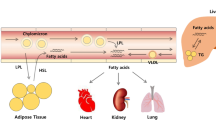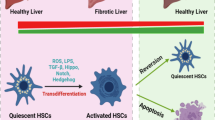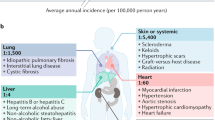Abstract
Chronic pancreatitis, liver cirrhosis or inflammatory bowel disease are examples of fibroinflammatory conditions, all of them characterized by a progressive course and poor therapeutic expectations. The signature of these disorders is the perpetual activation of myofibroblasts and the accumulation of redundant fibrotic tissue that progressively replaces the normal parenchyma. Removal of myofibroblast is increasingly recognized as a therapeutic target for the prevention and resolution of fibrosis. Tocotrienols are natural vitamin E compounds with potent anticancer properties. Their antineoplastic credentials are supported by the ability to selectively induce cell death or inhibit proliferation in transformed cells. Recent studies have shown that tocotrienols also strike activated fibroblasts without harming normal cells. This review focus on the current knowledge of the putative role of tocotrienols as antiinflammatory and antifibrogenic agents based on their ability to induce programmed cell death in activated fibroblasts. The review points out to the mitochondria as the main target of tocotrienols to promote apoptosis and autophagy in activated fibroblasts. Most of the available evidence has been gathered using experimental data from pancreatic stellate cells. The overall experimental evidence provides support to consider evaluating clinical trials using tocotrienols to reduce or prevent fibrosis in human fibroinflammatory diseases.
Access this chapter
Tax calculation will be finalised at checkout
Purchases are for personal use only
Similar content being viewed by others
References
Agarwal MK, Agarwal ML, Athar M, Gupta S (2004) Tocotrienol-rich fraction of palm oil activates p53, modulates Bax/Bcl2 ratio and induces apoptosis independent of cell cycle association. Cell Cycle 3:205–211
Aggarwal BB, Sundarama C, Prasada S, Kannappana R (2010a) Tocotrienols, the vitamin E of the 21st century: its potential against cancer and other chronic diseases. Biochem Pharmacol 80:1613–1631
Aggarwal BB, Sundaram C, Prasad S, Kannappan R (2010b) Tocotrienols, the vitamin E of the 21st century: its potential against cancer and other chronic diseases. Biochem Pharmacol 80:1613–1631
Ahn KS, Sethi G, Krishnan K, Aggarwal BB (2007) Gamma-tocotrienol inhibits nuclear factor-kappaB signaling pathway through inhibition of receptor-interacting protein and TAK1 leading to suppression of antiapoptotic gene products and potentiation of apoptosis. J Biol Chem 282:809–820
Behery FA, Elnagar AY, Akl MR, Wali VB, Abuasal B, Kaddoumi A, Sylvester PW, El Sayed KA (2010) Redox-silent tocotrienol esters as breast cancer proliferation and migration inhibitors. Bioorg Med Chem 18(22):8066–8075
Birringer M, EyTina JH, Salvatore BA, Neuzil J (2003) Vitamin E analogues as inducers of apoptosis: structure–function relation. Br J Cancer 88:1948–1955
Constantinou C, Papas A, Constantinou AI (2008) Vitamin E and cancer: an insight into the anticancer activities of vitamin E isomers and analogs. Int J Cancer 123:739–752
Dong LF, Low P, Dyason JC, Wang XF, Prochazka L, Witting PK, Freeman R, Swettenham E, Valis K, Liu J, Zobalova R, Turanek J, Spitz DR, Domann FE, Scheffler IE, Ralph SJ, Neuzil J (2008) Alpha-tocopheryl succinate induces apoptosis by targeting ubiquinone-binding sites in mitochondrial respiratory complex II. Oncogene 27:4324–4335
Elmore SP, Qian T, Grissom SF, Lemasters JJ (2001) The mitochondrial permeability transition initiates autophagy in rat hepatocytes. FASEB J 15:2286–2287
Elsharkawy AM, Oakley F, Mann DA (2005) The role and regulation of hepatic stellate cell apoptosis in reversal of liver fibrosis. Apoptosis 5:927–939
Elson CE (1992) Tropical oils: nutritional and scientific issues. Crit Rev Food Sci Nutr 31:79–102
Friedman SL (2008) Hepatic stellate cells: protean, multifunctional, and enigmatic cells of the liver. Physiol Rev 88:125–172
Fulda S, Galluzzi L, Kroemer G (2010) Targeting mitochondria for cancer therapy. Nat Rev Drug Discov 9:447–464
Gogvadze V, Orrenius S, Zhivotovsky B (2008) Mitochondria in cancer cells: what is so special about them? Trends Cell Biol 18:165–173
Hussein D, Mo H (2009) d-Dlta-tocotrienol-mediated suppression of the proliferation of human PANC-1, MIA PaCa-2, and BxPC-3 pancreatic carcinoma cells. Pancreas 38:124–136
Kaileh M, Sen R (2010) Role of NF-kappaB in the anti-inflammatory effects of tocotrienols. J Am Coll Nutr 29(3 Suppl):334S–339S
Kamal-Eldin A, Appelqvist LA (1996) The chemistry and antioxidant properties of tocopherols and tocotrienols. Lipids 31:671–701
Khosla P, Patel V, Whinter JM, Khanna S, Rakhkovskaya M, Roy S, Sen CK (2006) Postprandial levels of the natural vitamin E tocotrienol in human circulation. Antioxid Redox Signal 8:1059–1068
Kim EH, Sohn S, Kwon HJ, Kim SU, Kim MJ, Lee SJ, Choi KS (2007) Sodium selenite induces superoxide-mediated mitochondrial damage and subsequent autophagic cell death in malignant glioma cells. Cancer Res 67:6314–6324
Kroemer G, Pouyssegur J (2008) Tumor cell metabolism: cancer’s Achilles’ heel. Cancer Cell 13:472–482
Kuhad A, Chopra K (2009) Tocotrienol attenuates oxidative-nitrosative stress and inflammatory cascade in experimental model of diabetic neuropathy. Neuropharmacology 57:456–462
Luna J, Masamunt MC, Rickmann M, Mora R, España C, Delgado S, Llach J, Vaquero E, Sans M (2011) Tocotrienols have potent antifibrogenic effects in human intestinal fibroblasts. Inflamm Bowel Dis 17(3):732–741
Modica-Napolitano JS, Singh KK (2004) Mitochondrial dysfunction in cancer. Mitochondrion 4:755–762
Moretti L, Yang ES, Kim KW, Lu B (2007) Autophagy signaling in cancer and its potential as novel target to improve anticancer therapy. Drug Resist Updat 10:135–143
Nanji AA, Jokelainen K, Tipoe GL, Rahemtulla A, Dannenberg AJ (2001) Dietary saturated fatty acids reverse inflammatory and fibrotic changes in rat liver despite continued ethanol administration. J Pharmacol Exp Ther 299:638–644
Neuzil J (2003) Vitamin E succinate and cancer treatment: a vitamin E prototype for selective antitumour activity. Br J Cancer 89:1822–1826
Novo E, di Bonzo LV, Cannito S, Colombatto S, Parola M (2009) Hepatic myofibroblasts: a heterogeneous population of multifunctional cells in liver fibrogenesis. Int J Biochem Cell Biol 41:2089–2093
Oakley F, Meso M, Iredale JP, Green K, Marek CJ, Zhou X, May MJ, Millward-Sadler H, Wright MC, Mann DA (2005) Inhibition of inhibitor of kappaB kinases stimulates hepatic stellate cell apoptosis and accelerated recovery from rat liver fibrosis. Gastroenterology 128:108–120
Omary MB, Lugea A, Lowe AW, Pandol SJ (2007) The pancreatic stellate cell: a star on the rise in pancreatic diseases. J Clin Invest 117:50–59
Park SK, Sanders BG, Kline K (2010) Tocotrienols induce apoptosis in breast cancer cell lines via an endoplasmic reticulum stress-dependent increase in extrinsic death receptor signaling. Breast Cancer Res Treat 124:361–375
Patel V, Khanna S, Roy S, Ezziddin O, Sen CK (2006) Natural vitamin E alpha-tocotrienol: retention in vital organs in response to long-term oral supplementation and withdrawal. Free Radic Res 40:763–771
Ramachandran P, Iredale JP (2009) Reversibility of liver fibrosis. Ann Hepatol 8:283–291
Rickmann M, Vaquero EC, Malagelada JR, Molero X (2007) Tocotrienols induce apoptosis and autophagy in rat pancreatic stellate cells through the mitochondrial death pathway. Gastroenterology 132:2518–2532
Sakai M, Okabe M, Tachibana H, Yamada K (2006) Apoptosis induction by gamma-tocotrienol in human hepatoma Hep3B cells. J Nutr Biochem 7:672–676
Sen CK, Khanna S, Rink C, Roy S (2007) Tocotrienols: the emerging face of natural vitamin E. Vitam Horm 76:203–261
Serbinova EA, Packer L (1994) Antioxidant properties of alpha-tocopherol and alpha-tocotrienol. Methods Enzymol 234:354–366
Shibata A, Nakagawa K, Kawakami Y, Tsuzuki T, Miyazawa T (2010) Suppression of gamma-tocotrienol on UVB induced inflammation in HaCaT keratinocytes and HR-1 hairless mice via inflammatory mediators multiple signaling. J Agric Food Chem 58:7013–7020
Srivastava JK, Gupta S (2006) Tocotrienol-rich fraction of palm oil induces cell cycle arrest and apoptosis selectively in human prostate cancer cells. Biochem Biophys Res Commun 346:447–453
Sun W, Xu W, Liu H, Liu J, Wang Q, Zhou J, Dong F, Chen B (2009) Gamma-tocotrienol induces mitochondria-mediated apoptosis in human gastric adenocarcinoma SGC-7901 cells. J Nutr Biochem 20:276–284
Suzuki YJ, Tsuchiya M, Wassall SR, Choo YM, Govil G, Kagan VE, Packer L (1993) Structural and dynamic membrane properties of alpha-tocopherol and alpha-tocotrienol: implication to the molecular mechanism of their antioxidant potency. Biochemistry 32:10692–10699
Takahashi K, Loo G (2004) Disruption of mitochondria during tocotrienol-induced apoptosis in MDA-MB-231 human breast cancer cells. Biochem Pharmacol 67:315–324
Tappeiner C, Meyenberg A, Goldblum D, Mojon D, Zingg JM, Nesaretnam K, Kilchenmann M, Frueh BE (2010) Antifibrotic effects of tocotrienols on human Tenon’s fibroblasts. Graefes Arch Clin Exp Ophthalmol 248:65–71
Theriault A, Chao JT, Gapor A (2002) Tocotrienol is the most effective vitamin E for reducing endothelial expression of adhesion molecules and adhesion to monocytes. Atherosclerosis 160:21–30
Turcotte S, Giaccia AJ (2010) Targeting cancer cells through autophagy for anticancer therapy. Curr Opin Cell Biol 22:246–251
Wali VB, Bachawal SV, Sylvester PW (2009a) Combined treatment of gamma-tocotrienol with statins induce mammary tumor cell cycle arrest in G1. Exp Biol Med 234:639–650
Wali VB, Bachawal SV, Sylvester PW (2009b) Endoplasmic reticulum stress mediates gamma-tocotrienol-induced apoptosis in mammary tumor cells. Apoptosis 14:1366–1377
Wu SJ, Liu PL, Ng LT (2008) Tocotrienol-rich fraction of palm oil exhibits anti-inflammatory property by suppressing the expression of inflammatory mediators in human monocytic cells. Mol Nutr Food Res 52:921–929
Wynn TA (2008) Cellular and molecular mechanisms of fibrosis. J Pathol 214:199–210
Yam ML, Abdul Hafid SR, Cheng HM, Nesaretnam K (2009) Tocotrienols suppress proinflammatory markers and cyclooxygenase-2 expression in RAW264.7 Macrophages. Lipids 44:787–797
Yang Z, Klionsky DJ (2010) Eaten alive: a history of macroautophagy. Nat Cell Biol 12:814–822
Yang Z, Xiao H, Jin H, Koo PT, Tsang DJ, Yang CS (2010) Synergistic actions of atorvastatin with gamma-tocotrienol and celecoxib against human colon cancer HT29 and HCT116 cells. Int J Cancer 126:852–863
Yap SP, Yuen KH (2004) Influence of lipolysis and droplet size on tocotrienol absorption from self-emulsifying formulations. Int J Pharm 281:67–78
Yap SP, Yuen KH, Wong JW (2001) Pharmacokinetics and bioavailability of α-, γ- and δ-tocotrienols under different food status. J Pharm Pharmacol 53:67–71
Yap WN, Chang PN, Han HY, Lee DT, Ling MT, Wong YC, Yap YL (2008) Gamma-tocotrienol suppresses prostate cancer cell proliferation and invasion through multiple-signalling pathways. Br J Cancer 99:1832–1841
Yoshida Y, Niki E, Noguchi N (2003) Comparative study on the action of tocopherols and tocotrienols as antioxidant: chemical and physical effects. Chem Phys Lipids 123:63–75
Zhao Y, Neuzil J, Wu K (2009) Vitamin E analogues as mitochondria-targeting compounds: from the bench to the bedside? Mol Nutr Food Res 53:129–139
Author information
Authors and Affiliations
Corresponding author
Editor information
Editors and Affiliations
Rights and permissions
Copyright information
© 2012 Springer Science+Business Media Dordrecht
About this chapter
Cite this chapter
Vaquero, E.C., Molero, X. (2012). Tocotrienols in the Control of Pathological Fibroinflammatory Processes. In: Diederich, M., Noworyta, K. (eds) Natural compounds as inducers of cell death. Springer, Dordrecht. https://doi.org/10.1007/978-94-007-4575-9_20
Download citation
DOI: https://doi.org/10.1007/978-94-007-4575-9_20
Published:
Publisher Name: Springer, Dordrecht
Print ISBN: 978-94-007-4574-2
Online ISBN: 978-94-007-4575-9
eBook Packages: Biomedical and Life SciencesBiomedical and Life Sciences (R0)




